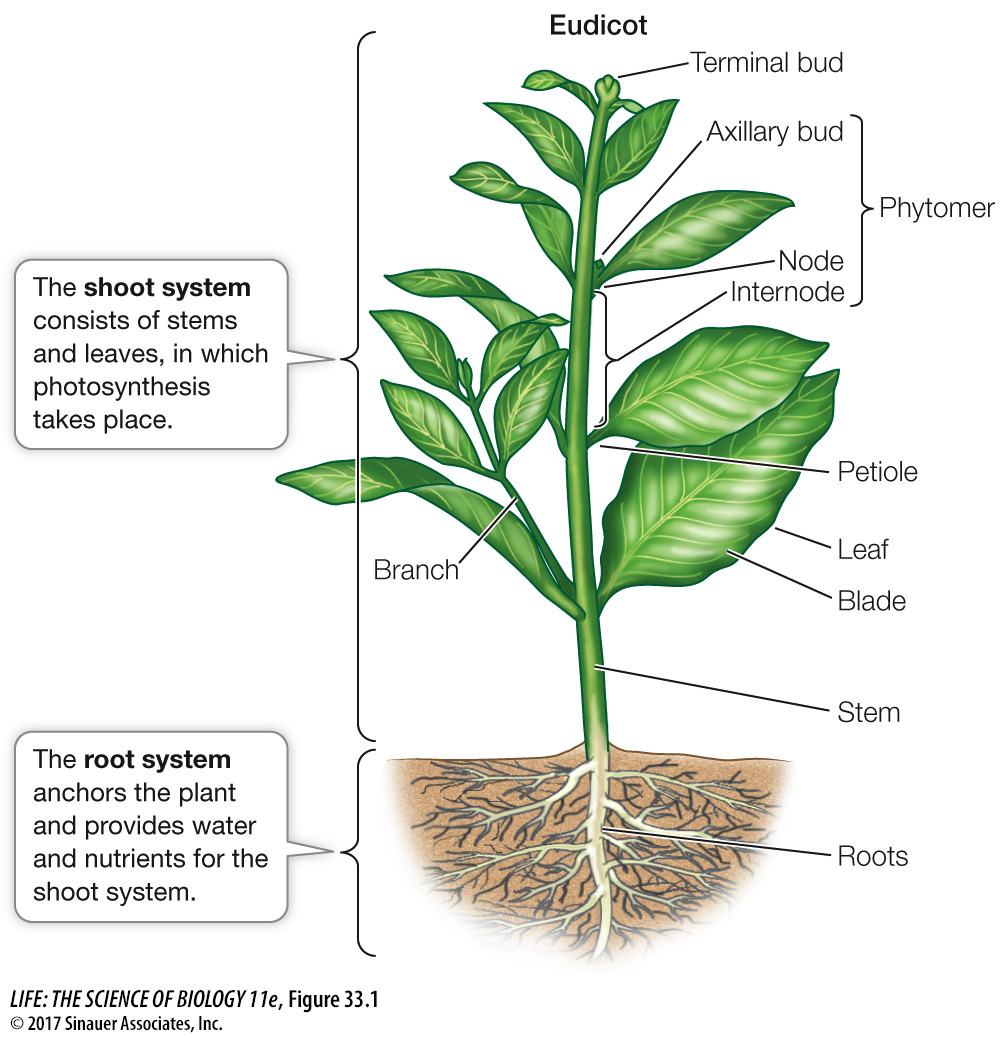key concept
33.1
The Plant Body Is Organized in a Distinctive Way
key concept
33.1
The Plant Body Is Organized in a Distinctive Way
Plants harvest energy from sunlight and collect water and mineral nutrients from the atmosphere and the soil. Because these resources are sometimes limited, plants must collect them from large areas, both above and below the ground. The plant is further challenged by its inability to move; a plant cannot, for example, relocate from a dry, shady location to one that is wet and sunny. The plant body plan responds to these challenges in two ways:
Stems, leaves, and roots enable a plant anchored to one spot to capture scarce resources effectively, both above and below the ground.
Plants can grow throughout their lifetimes, enabling them to respond to environmental cues. A plant can redirect its growth to exploit opportunities in its immediate environment; for example, it can extend its roots toward a water supply.
focus your learning
Plant growth patterns reflect challenges imposed by scarce resources and an inability to move.
Plant development is influenced by apical meristems, totipotency, vacuoles, and cell walls.
Two basic patterns that develop early in plant embryogenesis are apical–
basal polarity and radial symmetry.
Chapters 27 and 28 described how modern plants came from aquatic ancestors, giving rise to simple land plants and then to vascular plants. Despite their obvious differences in size and form, all vascular plants have essentially the same simple structural organization. This chapter describes the basic architecture of the largest group of vascular plants, the angiosperms (flowering plants), and shows how so much diversity can literally grow out of such a simple, basic form. There are more than 250,000 angiosperm species. A major distinguishing feature of angiosperms is flowers, which consist of modified leaves and stems and carry the organs for sexual reproduction. We will examine the structures and functions of flowers in detail in Chapter 37.
In this chapter we’ll focus on the three kinds of vegetative (nonsexual) organs that angiosperms possess: roots, stems, and leaves. Each of these vegetative organs can be understood in terms of its structure. By structure we mean both the overall form of the organ (its morphology) and the arrangement of its cells and tissues (its anatomy).
Plant organs are organized into two systems (Figure 33.1):

The root system anchors the plant in place, absorbs water and dissolved minerals, and stores the products of photosynthesis from the shoot system. The extreme branching of plant roots and their high surface area-
to- volume ratios allow them to absorb water and mineral nutrients from the soil efficiently. The shoot system of a plant consists of the stems, leaves, and flowers. Broadly speaking, the leaves are the chief organs of photosynthesis. The stems hold and display the leaves to the sun and provide connections for the transport of materials between roots and leaves.
Shoots and roots are composed of repeating modules called phytomers. Each phytomer in the shoot consists of a node carrying one or more leaves; an internode, which is the interval of stem between two nodes; and one or more axillary buds, each of which forms in the angle (axil) where a leaf meets the stem. A bud is an undeveloped shoot that can develop further to produce another leaf, a phytomer, a flower, or a flowering stem. The axillary buds (also called lateral buds) are distinguished from the bud at the end of a stem or branch, which is called a terminal bud. If it becomes active, an axillary bud can develop into a new branch, which is an extension of the shoot system. The arrangement of leaves along the stem (called phyllotaxy) is characteristic of plant species. Plant roots also have a modular construction. In the roots, each phytomer consists of a root segment between two branches.